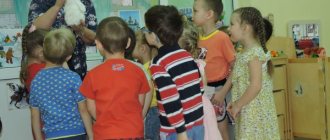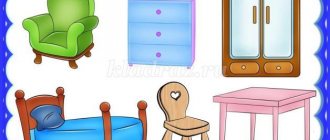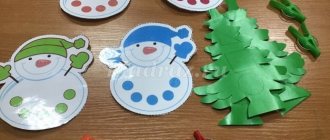OD summary in the preparatory group with the presentation “What types of transport are there?”
Summary of integrated organized educational activities for children 6 - 7 years old “What types of transport are there?”
Educational areas: cognitive development, speech development, artistic and aesthetic development Main activity: cognitive. Age of children: 6 - 7 years. Goal: to generalize children’s knowledge about transport (types of transport depending on the environment of movement and destination). Objectives: Educational:
- form concepts: ground, air, water;
freight, passenger, special transport; — introduce children to the emergence of various types of transport; — consolidate knowledge about the rules of safe behavior in transport. Developmental:
- activate children's vocabulary with words - names of vehicles;
- develop phonemic hearing, attention, memory, thinking, imagination, fine motor skills; - promote the development of fine motor skills of the hands and the graphic image of letters; — motivate children to solve problem situations. — improve children’s constructive activities: stimulate and support independent determination of a plan, create a holistic composition from elements. Educational:
- to cultivate interest in learning about the world around us;
- support children's initiative, intelligence, and independence; - cultivate a friendly attitude among children towards each other; - develop mutual assistance skills; — improve the ability to work in a team, while maintaining the individuality of each child. Educational technologies: problem-based learning technology, developmental learning technology, information and communication technologies, student-oriented technologies. Methodological techniques: reception of emotional interest (surprise moment), observation, demonstration of video recordings, conversation, problematic questions, provocative questions, reasoning, problematic tasks, dynamic pause, pedagogical assessment. Equipment: computer, projector, screen, presentation, magnetic board, pictures depicting various transport - 19 pieces, envelope, crossword puzzle, picture - wave, picture - cloud - picture - road, paper construction (bus parts), graphic exercises - 8 pieces, reflective elements - 8 pieces.
Progress of activities
Slide 1.
Children enter the hall and line up scattered. Educator: Hello guys! Do you know how people in other countries greet each other? In Japan they bow, in America they slap each other on the shoulder, in Italy they blow a kiss, in Europe they shake hands and say “Hello”, while saying their name. My name is Olga Ivanovna. (Shakes hand). And you? Very nice. Well, now we know each other and I can ask you to help me. Do you mind? The thing is that I prepared gifts for you, and now in my basket instead of gifts there are some pictures? Are these not your pictures? Slide 2. Shapoklyak: Of course not yours, because these are my pictures! Educator: Hello, dear... guys, who is that on the screen? Children: Shapoklyak. Educator: Hello, Shapoklyak! Why are there your pictures in my basket and where are the gifts for the guys? Slide 3. Shapoklyak: - Well, what’s incomprehensible here? I swapped them! I'm being naughty! This is nature! Educator: Guys, what should we do? (children speak). Dear, how can we return our gifts? Slide 4. Shapoklyak: Correct question! If you complete all my tasks, you will find your gifts. For correct completion of tasks I will give you a letter. Collect all the letters and find out where your gifts are. If you make a mistake, you will never find them. I’ll give you a hint - task 1 is already in front of you. Bye, my reasonable ones!!! Educator: Well, guys, let's try to find our gifts? Let's see what lies here: a boat, a train... What do you think is the secret? Maybe some picture is superfluous? (an extra picture of Emelya on the stove, or a stupa with Baba Yaga or a carpet - an airplane). Slide 5. Shapoklyak: Look, you are so nimble, you coped with the task. Well done, catch your first letter, be-be-be. Slide 6. The letter “K” appears on the screen Educator: Okay, guys, we found one letter. Now we need to think about how we will find everyone else. Look, there is some kind of letter in the basket (takes out the letter and shows it to the children). Slide 7. Shapoklyak: Not some kind, but a talking one. Here is your second task, listen to it and guess what sounds are hidden in it. Slide 8 (sound of the city) Educator: Guys, what do you hear? (children say they hear different sounds). Absolutely right, we hear the sounds of a big city, its roadway, where there are many different vehicles and each has its own unique sound. I suggest you now guess what sound of transport we will hear now. So, be careful. slide 9 train sound. Slide 10 sound of an airplane. Slide 11 the sound of a steamboat. Slide 12. Shapoklyak: Oh, you guessed it again. What smart kids! Catch the second letter. Slide 13. The letter “A” appears on the screen. Slide 14. Shapoklyak: And now, the task is more difficult. Solve the crossword puzzle and find my favorite letter in it. Slide 15. Educator: Guys, look, we have a crossword puzzle and many different pictures. I would like to draw your attention to the columns; at the top of each column there is an icon (in the first column there is a wave, in the second there is a road, in the third there are clouds). How do you think we should place the pictures using these tips? And below, under the columns, we will place those pictures that are not at all related to transport (children place pictures in a crossword puzzle). We have completed the task. Remember, Shapoklyak told us that we must find her favorite letter. Where can we find her? (draws the children’s attention to the shape of the crossword puzzle).
Slide 16.
Shapoklyak: Smart, right? Have you reached the letter of my favorite letter? Well, I'll have to give it to you, catch it. Slide 17. The letter “Ш” appears on the screen. Slide 18. Shapoklyak: Well, we did it, okay. I have something more complicated for you. Guys, design me a type of transport so that all my friends can fit in it. Educator: Guys, do you know where cars appear on the streets of the city (children's answers: car showroom, store...). I'll tell you a secret, cars are made at a car factory. Many designers, engineers, and mechanics work on the creation of cars. I suggest you go to the design bureau. But our journey is not short, let's take seats in the blue trailer. And before you hit the road, let's remember the rules of behavior in public transport. Attention to the screen (click 3 more times, poems about the rules of behavior)
.
Slide 19. Educator: So, let's hit the road! Slide 20. A video with the song “Blue Car” appears on the screen (physical education lesson) Educator: Here we are. Educator: Creating a car begins with a drawing on a sheet of paper. I suggest that each of you create a drawing of your future car. I would like to draw your attention to the fact that for this you need to be able to count to 20. Choose (children choose drawings). Slide 21. (Children sit down at the tables and begin to complete the task. The teacher examines the resulting drawings and, together with the children, determines the type of transport: cargo, passenger, special equipment).
Slide 22.
Educator: How many transport models we have! Who can remind me which of these models we need to choose in order to design a car for Shapoklyak (children express their guesses). That's right, she asked for a type of transport that could accommodate all her friends. What drawing do we need to choose (car or bus, children choose the proposed parts and lay out the car or bus on A4 sheet). Slide 23. Shapoklyak: Well, no difficulties scare you! So be it, catch the last letter and look for your gifts. See you soon, my smart, smart kids! Bye - bye, ha ha ha. Slide 24. The letter “F” appears on the screen. Slide 25. Educator: And now it’s time to open our envelope with letters.
Guys, I can't read this word. What do you think should be done with the letters (from the given letters the children form the word “CLOSET”). So this is where to look for gifts. Shapoklyak hid them in the closet. Slide 26. Slide 27. Presentation on the topic: Transport
We recommend watching:
GCD for the development of coherent speech in a preparatory group using ICT. Context of a lesson in a preparatory group using ICT. Traveling to hot countries Summary of a lesson using ITK on the formation of a civil-patriotic position in the senior group Quiz for children of the preparatory group on the topic: Electric transport
Similar articles:
Summary of a lesson in the preparatory group on the topic “Special transport”
Integrated lesson “History of transport”
Summary of an integrated lesson in a pre-school group using the “Magic Screen” technology
Subject:
History of transport
Tasks:
Cultivate an interest in the history of transport.
Learn to navigate the past, present, and future. Develop cognitive interest in the process of experimentation, the ability to draw conclusions. Continue to teach how to perform the ZAS, identify the first sound in a word and correlate it with color. Focus on planes, ability to solve problems. Develop memory, attention, logical thinking, speech. of OUD
Greetings in three languages
Today we will take you on a journey along the river of time. In front of you are pictures, I invite you to send them along the river of time, each to the corresponding era. (sort)
Control questions:
How to call all the pictures in one word? (transport)
What pictures have we attributed to the past? real? What do you think about the future? (nothing because we don’t know what transport will be in the future)
Guys, today we will visit the past, present and future and interesting tasks await us in each time.
And in order to go on a journey into the past, we need to close our eyes and say the words
Time rushes by, the river is wide and deep.
River, river, don’t rush, tell us about the past.
And now we find ourselves in the past.
I have prepared a chest of inventions for you. The chest contains an invention of an ancient man. The invention is familiar to you. Guess a riddle about him
There is no one more important in the cart than him
What are these children? (wheel.)
I take a wheel out of the chest
1. Children, who invented the wheel? (Human)
2. When did man invent the wheel? (in the distant past)
3. Why does a person need a wheel? ( to move faster)
Yes, guys, the man really wanted to move faster, and he came up with a wheel
THE WHEEL is a great invention of mankind that changed people's lives.
Let's do an experiment with a wheel. Do you agree? Go to the tables
Experience
-There are figures on a plate in front of you.
Name what shapes these are?
.How to call them in one word?
Let's take a triangle and try to ride it? Rolling? Why? Let's take a square. Does it roll? Why?
Let's take a circle. Is it rolling? Why? (because it is round and has no corners)
Conclusion: Only round objects roll
Let's make a wheel for a cart
If you take a thick tree trunk and cut it crosswise several times, you will get a lot of round wooden disks. Will it be a wheel? (no, because it won’t roll for a long time and will fall.)
Because guys, the wheel has a secret that the round wheel doesn’t have - a hole in the middle.
Why does the wheel have a hole in the middle? (to insert an axis)




